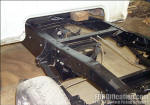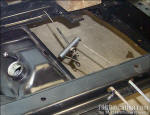|
Friday,
May 27, 2005 - Sorry for the lack of recent
updates, but normal life has been keeping me busy, so I haven't
gotten in a lot of shop time lately.
I
sold the '67 F250 bed to a FORDification forum member a couple
weeks ago. We made arrangements for him to drive out from
Kentucky this Memorial Day weekend to pick it up on Saturday.
Since I hadn't had the time to get it disconnected and ready to
go, I decided to take a vacation day on Friday to get that done.
However, I got caught up on work early Thursday afternoon, so I
went ahead and took the rest of the day off, and hit the shop to
get started on removing the bed. Because this was such a
low-mileage truck, all the bed's attaching bolts were very easy
to remove, and it took me less than an hour to have it ready to
go by the time I went home Thursday evening.
However, that now meant I had a whole day to myself to spend in
the shop on Friday. I decided to go ahead and get the fuel tank
installed, to complete the rolling chassis. Almost everything
was ready to install, so it really didn't take that long. I had
to enlarge the frame holes a bit to mount the skidplate, but
other than that, it went quickly and smoothly...until I went to
hook up the emergency brake setup.
Trucks with this auxiliary tank have a different e-brake setup
than those trucks not so equipped. First, the cable from the
e-brake pedal assembly in the cab back to the frame crossmember
is longer, because it has to essentially wrap around the tank.
It's connected on the forward corner of the tank and then snaps
into the frame crossmember. Also, trucks without the auxiliary
tank have a lever-style equalizer mechanism (Fig. 2) that will
interfere with the tank, so the lever must be removed and
a slightly different setup is used (Fig. 3).
The
F250's front e-brake cable works just fine on my F100, even
though it's a LWB truck....the front cable is the same length
for both LWB and SWB trucks. The difference in length is made up
for with short cable extensions between the front and rear
cables.
Fig.
4 shows the routing of the e-brake cable around the tank. You
can see how it's attached to the front corner of the tank and is
then attached with a clamp to the tank's crossmember. What you
can't see is how it snaps into a hole in the frame crossmember
using tabs exactly like those on the rear cables at the brake
backing plate. |

Fig. 1 - Here's a shot of the completed installation
of the in-frame 25-gallon fuel tank.

Fig. 2 - This is what the standard e-brake setup looks
like. You can see where it will contact the tank, so a different
configuration is necessary.

Fig. 3 - Here's the setup used for trucks with the
auxiliary tank. There will eventually be a spring installed
which will extend from the L-bracket (hanging on the end of the
cable here) to the frame crossmember.

Fig. 4 - The e-brake cable routing is shown here. |